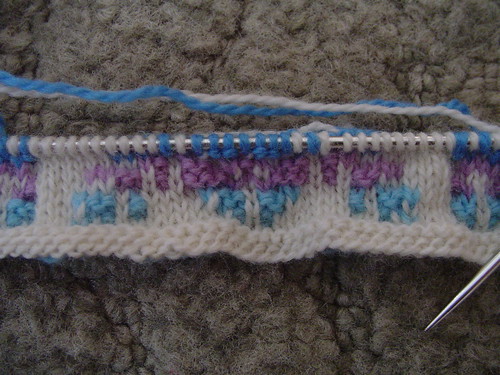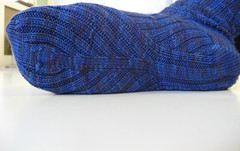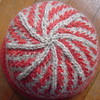Vertical Stripes sweater - getting started and PWYC
As promised, I cast on for the Vertical Stripes sweater on Friday. I decided to knit two rows flat (to produce garter stitch, not stockinette), before joining in the round and starting the colorwork pattern. I found that the one purl row in my swatch wasn't deep enough to ensure that the floats from the first row of colorwork would be hidden, so this seemed like a good solution.
This pattern is a bit difficult to work out at first. The directions in the book are minimal, and the charts are used in unorthodox ways. There are two charts, and you work chart A, chart B, then chart B backwards and chart A backwards. That makes up the front of the sweater, and then you go back and do it again. What makes things more complicated is that you start the sweater a bit before the side seam, and you pivot when you turn, meaning that the last chart stitch before you turn directions on the chart isn't knit again going the other way. All of these things added up to a big headache when I was trying to figure out exactly how to use the charts so I'd start and stop in the right places, and end up knitting the same number of stitches that were cast on. I managed to figure it out. I don't want to bore you with the dirty details of it all, but if anybody else is knitting the Vertical Stripes sweater and wants a tutorial on how it all goes together, please leave a comment or send an email. I'd be happy to share the information, to spare you all the headaches and possible tinking you may have to do to get it right on your own.
That made it sound a lot worse than it really was. Really, once I got it, it wasn't bad at all. I was nervous that it would be difficult to follow the charts from left to right. I've obviously done that for wrong side rows with lace and cable charts, but the thing is, it's never been complicated for those. For lace charts, I've always had plain purl rows going back, and for cables, I think I've always had charts that just told you to work the stitches as they appear when going back across the wrong side. But to my pleasant surprise, my brain has no trouble following complex colorwork charts from left to right while knitting from right to left, so I'm happy.
I'm only about 8 or 9 rows in, so I'm still using the purl when you can technique. I'm still undecided on how I like it. It does seem to be doing the job fairly well, and I'm certain that any ripples will block out later on, perhaps with the assistance of a couple of heavy books placed on the hem. I think the purls look sloppy, though, and make it hard to really see the colorwork pattern. Right now, I'm just going to be optimistic, and tell myself that once I have more knit, and more pattern repeats that show the pattern nicely in knit-only stitches, the purl when you can section will not look so chaotic. Here's a photo of what I have so far:

This sweater is going to go extremely slowly. I think it's taking about half an hour per row right now. There will be approximately 220 rows in the body of the sweater. I think things will speed up a bit once I get past the purl when you can section, and once I make photocopies of the charts and get a second magnet, so I can follow along without turning the book around every few minutes. (The charts in the book are on different pages, and in different orientations.)
By the way, Inox needles are sharp. I punctured my right index finger and drew blood Friday night. Then managed to draw more blood as I adjusted the bandaid, pulling off hanging cuticle skin. Then I slammed my middle finger between a chunk of wood and the wood stove, giving myself a couple of impressive looking blood blisters. My hand is mangled, but thankfully no longer in pain. So here's to more knitting, more watching ski jumpers and figure skaters (c'mon Shen and Zhao, you can do it!), and the anticipation of the first knitalong progress post on Wednesday. What an exciting week this will be. :-)
This pattern is a bit difficult to work out at first. The directions in the book are minimal, and the charts are used in unorthodox ways. There are two charts, and you work chart A, chart B, then chart B backwards and chart A backwards. That makes up the front of the sweater, and then you go back and do it again. What makes things more complicated is that you start the sweater a bit before the side seam, and you pivot when you turn, meaning that the last chart stitch before you turn directions on the chart isn't knit again going the other way. All of these things added up to a big headache when I was trying to figure out exactly how to use the charts so I'd start and stop in the right places, and end up knitting the same number of stitches that were cast on. I managed to figure it out. I don't want to bore you with the dirty details of it all, but if anybody else is knitting the Vertical Stripes sweater and wants a tutorial on how it all goes together, please leave a comment or send an email. I'd be happy to share the information, to spare you all the headaches and possible tinking you may have to do to get it right on your own.
That made it sound a lot worse than it really was. Really, once I got it, it wasn't bad at all. I was nervous that it would be difficult to follow the charts from left to right. I've obviously done that for wrong side rows with lace and cable charts, but the thing is, it's never been complicated for those. For lace charts, I've always had plain purl rows going back, and for cables, I think I've always had charts that just told you to work the stitches as they appear when going back across the wrong side. But to my pleasant surprise, my brain has no trouble following complex colorwork charts from left to right while knitting from right to left, so I'm happy.
I'm only about 8 or 9 rows in, so I'm still using the purl when you can technique. I'm still undecided on how I like it. It does seem to be doing the job fairly well, and I'm certain that any ripples will block out later on, perhaps with the assistance of a couple of heavy books placed on the hem. I think the purls look sloppy, though, and make it hard to really see the colorwork pattern. Right now, I'm just going to be optimistic, and tell myself that once I have more knit, and more pattern repeats that show the pattern nicely in knit-only stitches, the purl when you can section will not look so chaotic. Here's a photo of what I have so far:

This sweater is going to go extremely slowly. I think it's taking about half an hour per row right now. There will be approximately 220 rows in the body of the sweater. I think things will speed up a bit once I get past the purl when you can section, and once I make photocopies of the charts and get a second magnet, so I can follow along without turning the book around every few minutes. (The charts in the book are on different pages, and in different orientations.)
By the way, Inox needles are sharp. I punctured my right index finger and drew blood Friday night. Then managed to draw more blood as I adjusted the bandaid, pulling off hanging cuticle skin. Then I slammed my middle finger between a chunk of wood and the wood stove, giving myself a couple of impressive looking blood blisters. My hand is mangled, but thankfully no longer in pain. So here's to more knitting, more watching ski jumpers and figure skaters (c'mon Shen and Zhao, you can do it!), and the anticipation of the first knitalong progress post on Wednesday. What an exciting week this will be. :-)











2 Comments:
I think the purls will make the sweater quite three-dimensional. And I like that.
Ow, if you don't have to, don't make the injuries worse with more knitting until the fingers have healed. :)
Try explaining the injury to your HMO. Better hope you have a knitting medical person. Like you, I don't like the looks of the purl stitches either. Of course they are at pretty big magnification. Will watch with interest as haven't used that technique yet.
Anne
Post a Comment
<< Home